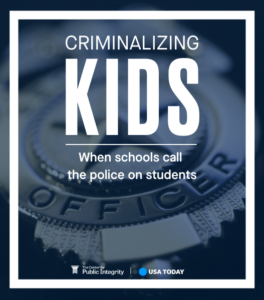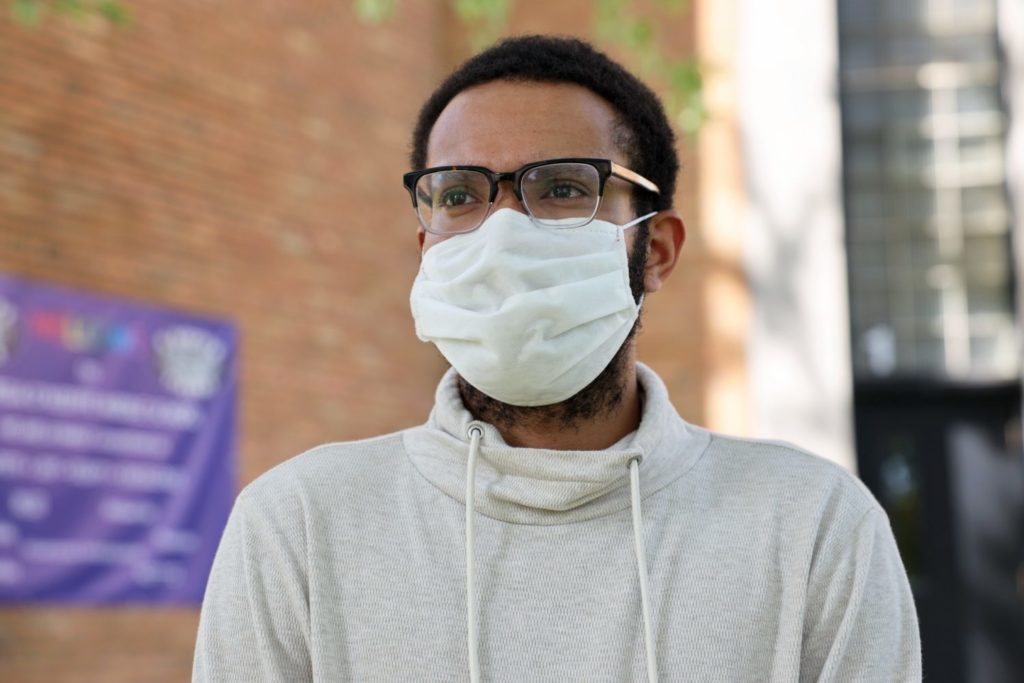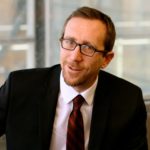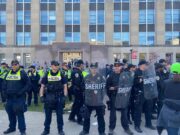This story was produced as part of a collaboration with the Center for Public Integrity, USA TODAY and WisconsinWatch. We published CPI’s reporting on the issue at a national level yesterday.
 In June 2019, three officers from the Madison Police Department (MPD) brutally attacked a Black student who attended West High School. The then-17-year-old boy had mental health issues and had not taken his medication for several days. After an incident at school, the teen left school and walked home. After arriving home, as he was entering the living room from his shower, he was attacked by the officers.
In June 2019, three officers from the Madison Police Department (MPD) brutally attacked a Black student who attended West High School. The then-17-year-old boy had mental health issues and had not taken his medication for several days. After an incident at school, the teen left school and walked home. After arriving home, as he was entering the living room from his shower, he was attacked by the officers.
As his head was being held down, an officer put a bag, referred to as a “spit hood,” over his head and punched the side or back of his head at least three times. The incident report stated that, “one officer delivered several strikes during the encounter in an attempt to gain control of the subject.” Madison365 has chosen to not identify the teen or his family to protect their privacy.
This is just one example of the violence Black, Latino, Indigenous students and students with disabilities can experience when teachers and school administrators call law enforcement over truancy and other school discipline issues. The intersection of identities also contributes to the disciplinary methods used on these students. The Center for Public Integrity has analyzed data from the U.S. Department of Education gathered during the 2017-2018 school year about the consequences of school policing that disproportionately affect Black, Latino, and Indigenous students, and students with disabilities.
The data reported that nationally, 4.5 of every 1,000 students were referred to law enforcement during that school year. Wisconsin referred twice as many — nine students for every 1,000 — to police or law enforcement. More than half of Wisconsin’s school districts — 273 out of the 448 — reported that they made referrals in the 2017-2018 school year.
Wisconsin reported the highest national referral rates in the country for Pacific Islander and Indigenous students. Indigenous students are referred over three times as often as white students, a higher rate than any other state in the nation. They are 184% more likely to be referred than their share of the student population.
The state also reported that Black students are referred almost three times as often as white students, a higher rate than all but four states (South Dakota, New Hampshire, Pennsylvania, and Virginia). They are 123% more likely to be referred than their share of the student population.
The data analyzed by the Center for Public Integrity also showed that white students in Wisconsin are 16% less likely to be referred than their share of the student population.
Wisconsin reported the second-highest referral rate in the country for students with disabilities, who are 124% more likely to be referred than their share of the student population.
In the 2017-18 school year, the most recent year data are available, the school districts reporting the highest rates of referral were Webster, White Lake, Unity and Lakeland. Lakeland, Webster and Unity also reported high rates of referring Native students, as did the Seymour Community District.
Black students, whose rate of referral in Wisconsin is only slightly below that of Native students, were referred most often in the Sparta Area School District, followed by Sheboygan Falls and Portage Community. (Schools referring fewer than five students in any category were excluded from the analysis.)
As for students with disabilities, White Lake reported the highest rate of referral, followed by the Webster, Rhinelander and the Dodgeville school districts.
Milwaukee’s rate of 7.2 per 1,000 students referred to police was below Wisconsin’s overall referral rate of 9 but higher than the national rate of 4.5. Likewise, Madison’s reported 6.2 students referred per 1,000 was also higher than the national rate.
Click the top of each column to sort the table by that column. The table is also searchable.
Police interactions can be traumatic
It’s an issue that most school districts don’t want to discuss. Madison365 reached out to officials with the school districts in Milwaukee, Green Bay, Appleton, Middleton, Verona, Superior, Lake Geneva, Westosha, Seymour, Portage, West DePere, Stoughton, Saint Francis and Beaver Dam; most either ignored our requests or declined to comment.
In an emailed statement, Stoughton School District Community Information and Resource Coordinator Molly Shea wrote, “We have done thoughtful work in the past several years to promote all types of equity, including racial justice. We’ve come a long way as a community and this is because of the work we’ve chosen to do together. With that being said, these instances deeply trouble us. Racism and racial disparities continue to be a problem in our schools and in our community. That’s why we are largely focused on providing equitable instruction to all students; supporting our educators and staff in understanding their role, identity, and responsibility within the system; and ensuring a multi-level system of supports. This is all with the goal of a just, inclusive school community and to increase feelings of belonging in our students.”
Madison school board members were willing to speak months after the district canceled its contract with the Madison Police Department and weeks into its first full school year with no police officers in its buildings.
Savion Castro is a Black man with a disability, an alumnus of Madison Metropolitan School District (MMSD), and current MMSD School Board vice president. He attended LaFollette High School from 2009-2013. During his time there, the school had a service station and School Resource Officers (SROs). He recalls his experience with SROs and the effects their presence had on him.

“I had a few encounters with the officer,” Castro said. “Primarily the officer was a part of our Restorative Justice Training Program. At that time restorative Justice was still seen as just an alternative to discipline or getting a ticket or being arrested by the SRO or getting suspended or detention, things like that. I didn’t receive any serious behavioral calls that would usually involve the SRO, but I certainly had friends that did. It pretty much manifested from common misunderstandings amongst students and escalated to larger conflicts, and a staff member would usually call the SRO to help de-escalate that conflict, or they would call the SRO to escort a student out of the classroom. You just kind of had to witness that your peer was being removed out of the classroom for allegedly being disruptive or something like that.”
Castro reflected on his time as a student of color with a disability in MMSD. During his campaign for the MMSD School Board, he said that as community members, we have the power and agency to transform our schools into the equitable learning communities that all students deserve. He wanted police out of schools because of the negative impacts their presence has on Black and brown students, and students with disabilities.
“I think what an officer ultimately does, it’s the threat of lethal violence, or of the criminal justice system,” said Castro. “I think it’s just another point of entry in our school systems, where students can be kind of whisked off into this school-to-prison pipeline. I think that there are more healthy, more effective means of helping students navigate conflict amongst each other. And I think that there are serious actions to be taken with certain students experiencing bias and discrimination from staff members within our school, where they think they need to call an officer on a 14-year-old child.”
University of Wisconsin law professor Ion Meyn said in an interview that police interactions can be traumatic for the students.

“And also in terms of processing that interaction, you’re talking about a child who doesn’t have the maturity and brain development that an adult has, so it only exacerbates those underlying issues of trauma,” Meyn said. “And then it also obviously traumatizes the family. And it also paints that kid as a problem, both to the kid, because it’s defining and self-defining for the child, and for the surrounding community. And that then entrenches racism and racial, racist views in the children that then have lifelong impact for both the subject and those who witnessed it.”
“A rough year”
The 2017-18 school year was difficult at Lakeland Union High School. Disciplinary problems came in waves for the Oneida County school — in February 2018, two students were arrested for making threats — just days after the mass shooting at Florida’s Marjory Stoneman Douglas High School.
“That was a rough year,” said Chad Gauerke, the school principal. Lakeland referred over 6% of its students to police, including the two teenagers, whose separate threats shut down the school for a day.
But one-third of the 45 referrals were for possession of tobacco, Gauerke said. Under state law, that is a minor infraction in which the maximum penalty is seizure of the product by police.
That year, Lakeland was at the top of the list for referring Indigenous students, and near the top of the list for referring students overall.
Diana Cournoyer, the executive director of the National Indian Education Association, called the numbers “appalling” and “disturbing.” But, she said, “I’m not surprised. Every Native person knows this, whether you’re in Wisconsin or not.”
Gauerke said his school recognizes the disparity. He said Lakeland has been working with a top University of Wisconsin-Madison researcher to reduce the school’s disciplinary issues. “We’re being transparent looking at behavior modifications and what we can do differently,” he said. “We’re doing a lot of extra work to lower those (numbers).”
Some educators also said the data can be misleading. Reporting standards, they said, often vary by district.
The definition of a law enforcement referral is “really wide open,” said Nathan Hanson, district administrator of the White Lake School District in Langlade County. “It’s kind of up to school districts to figure it out.”
Brandon Robinson, district administrator of the Unity School District in Polk County, agreed. He said that the data from Unity was “inflated” due to the district’s broad interpretation of “law enforcement referral.” In Unity, the term also covers outreach to county social services. The “referral,” Robinson wrote in an email, could simply represent “a conversation with a juvenile justice caseworker,” or referral for a student in crisis.
Hanson, who has worked in four different school districts and was responsible for reporting data in one, also noted that different counties can take different approaches to the same disciplinary problems. In some, truancy is reported to social services. In others, the police department is notified.
“When I talked to people around here, it wasn’t uncommon (in 2017-18) to give a police referral for swearing at a teacher — things that are disorderly conduct,” Hanson said. “But now we’d look at handling that in house.”
One academic year also provides a small sample size. Hanson said in small districts like White Lake, rates can fluctuate significantly from year to year. In 2020-21, for example, White Lake reported zero referrals, he said.
Students should be involved in SRO decisions, DOJ official says
Ajamou Butler is a Milwaukee native and resident, and founder of Heal the Hood MKE. He is a community activist, educator, and spoken word artist. Butler went to elementary and middle schools in Milwaukee and moved to Madison to attend high school. He says he didn’t see police officer activity in his schools until he moved to Madison.
“The police weren’t in the school. Their presence was after school and before school, when the congregating took place. And it was wild because they still couldn’t stop the stuff that was going down,” Butler said. “They still couldn’t stop people from getting jumped. They still couldn’t stop people from fighting, driving crazy. I went to Madison in 2008, graduated in 2009. So, to see all this stuff still occurring to the degrees they are is really interesting.”
Butler works in high schools in Milwaukee and sees the disparities in Black and brown communities.
“My understanding and my experiences come from my adult lens, working in the high schools,” said Butler. “And now really going into some of these alternative high schools. One of the first alternative schools I worked in was Bay Views Alternative High School, it’s a high school here on the South side. Seeing the level of street that the kids come from, they literally come from the slums. There’s 19-year-olds with three kids and they’re sophomores in high school. When you put pressure and you mix poverty in with that pressure, there’s going to be explosions. There’s no question about it.”
Kristen Devitt, Director of the Office of School Safety at the State of Wisconsin Department of Justice, said that schools need to think about why they want police in their schools and the goals their presence will accomplish. She said that SROs are in schools to be a resource and support students in their educational journeys.
“But we can measure, are they achieving certain goals?” Devitt said. “If the goal is that, they’ve been dealing with a lot of truancy issues, and they want the SROs to support getting the kids in schools and staying in school. If they’ve been dealing with really significant dating violence issues, and we want the SROs to provide education to students about what is power and control, and what does that look like, which is something that I did when I was in the high school. Or if we want the SROs to be in the classroom, talking about a variety of different topics, then that needs to be addressed. If the goal is to simply enforce the law and to arrest the kids, then a patrol officer could do that, if that was their main goal. But the main goal that is always recommended for SROs when they’re going into the schools, is to build relationships with students. Occasionally, there may be circumstances where behavior dictates law enforcement response. However, the overriding goal should be that they are building positive relationships with students and that and that they’re supporting the students, and they’re actually acting as a resource to the school community.”
Under Devitt’s leadership, the Office of School Safety at the Wisconsin Department of Justice is now conducting training for schools on adolescent mental health. Devitt concluded that the decision to have police presence in schools needs to be made by the entire community of that school.
“From my own personal experiences, for officers that want to work in schools and want to work with kids, I think it’s an ideal situation for them,” said Devitt. “But every community needs to make its own decision about whether or not they want to have law enforcement in their schools. Not only that, but they need to think about what is the goal for having a police officer in their school. Simply saying, ‘well, I just want one there’, that is not something that we can measure. We can’t measure the want to have a police officer in the school.”
Devitt suggested that community members, including students, faculty and school administrators should collectively discuss what safety in their school will look like. All schools are different, and she emphasized that student input is critical to the overall success and safety of the school.
“There’s also room for understanding what it is that the school needs and wants,” said Devitt. “And I think the student voice has to be a big part. I think it’s much more common now, especially, in the selection process with the school resource officer, that schools be a part of that process. Maybe the building principal or superintendent will sit down and be a part of the interview panel for that position. But it’s not so common to have students be a part of that interview process and I think that they should be. Those schools are going to have an SRO because the community has decided this is what they want, then there should be student voice involved. A student should have a part in that, which I think creates a greater path to understanding and sets the tone that the students in this building are important and they’re important enough to be at the table and be a part of this conversation.”
No cops in schools, says law professor
Law professor Meyn was unequivocal, saying police should “absolutely not” have any presence in school buildings.
“They should not be there,” he said. “I don’t think that makes schools more safe. It doesn’t make students of color feel more safe. And so it has to be from the perception of the entire community of what you’re trying to kind of broadcast. I also think that if you have someone there, they’re just more apt to use them, and I think you should try much harder not to.”
The data analyzed by the Center for Public Integrity also showed that white students in Wisconsin are 16% less likely to be referred than their share of the student population. Students who are Black, Latino, Indigenous or have disabilities are targeted at higher rates than their white peers. Police presence can negatively impact student success, which is why many communities are re-evaluating if they want to keep officers in their schools. In 2020, MMSD’s School Board voted to end their contract with MPD, which stops police presence in Madison schools.
“The over policing, as it pertains to the school system, is so prevalent,” Butler said. “It’s absurd how prevalent it is. And on one hand, I get it. I know how we get down in the ghettos. I know how overwhelming that is to send a child to an institution to learn and then this happens and that happens. And you gotta have some extra reinforcements because the security guards aren’t good enough. They’re in on the mess too. These MPS security guards involve themselves with the drama between the students. They help to instigate and infiltrate all the drama. It’s multiple levels to police involvement, but what we see nowadays is ridiculous.”




























